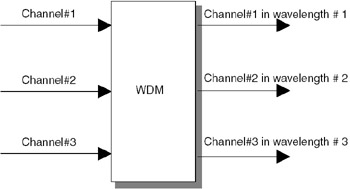7.4 WAVE DIVISION MULTIPLEXING
|
| < Day Day Up > |
|
7.4 WAVE DIVISION MULTIPLEXING
Wave division multiplexing (WDM) is used in optical fibers. In optical fiber communication, the signal corresponding to a channel is translated to an optical frequency (generally expressed in wavelength) and transmitted. This optical frequency is expressed by its equivalent wavelength and denoted by λ (lambda).
Instead of transmitting only one signal on the fiber, if two (or more) signals are sent on the same fiber at different frequencies (or wavelengths), it is called WDM. In 1994, this was demonstrated—signal frequencies had to be separated widely, typically 1310 nm and 1550 nm. Therefore, just using the two wavelengths can double the fiber capacity.
As shown in Figure 7.6, the wave division multiplexer takes signals from different channels, translates them to different wavelengths, and sends them through the optical fiber. Conceptually, it is the same as FDM.

Figure 7.6: Wave division multiplexing.
Wave Division Multiplexing is used in optical fibers. Data of different sources is sent through the fiber using different wavelengths. The advantage of WDM is that the full capacity of an already laid optical fiber can be used.
Note that in WDM, single-mode fiber carries the data of different channels in different wavelengths. The advantage of WDM is that the full capacity of an already laid optical fiber can be increased by 16 to 32 times by sending different channels in different wavelengths. Because each wavelength corresponds to a different color, WDM effectively sends data corresponding to different channels in different colors.
7.4.1 Dense Wave Division Multiplexing
As the name implies, dense wave division multiplexing (DWDM) is the same as WDM except that the number of wavelengths or ones can be much higher than 32. Multiple optical signals are combined on the same fiber to increase the capacity of the fiber. One hundred twenty-eight and 256 wavelengths can be used to transmit different channels at different rates. DWDM is paving the way for making high bandwidths available without the need for laying extra fiber cables. Data rates up to terabits per second can be achieved on a single fiber.
DWDM is an extension of WDM—a large number of wavelengths are used to transmit data of different sources. Data rates up to the terabit level per second can be achieved using DWDM.
Summary
Various multiplexing techniques have been discussed in this chapter. In frequency division multiplexing (FDM), different channels are translated into different frequency bands and transmitted through the medium. In time division multiplexing (TDM), the data corresponding to different channels is given separate time slots. Wave division multiplexing (WDM) and dense WDM (DWDM) facilitate transmission of different wavelengths in the same fiber. All these multiplexing techniques are used to combine data from different sources and to send it over the medium. At the receiving end, demultiplexing separates the data of the different sources.
References
-
R. Horak. Communications Systems and Networks. Wiley-Dreamtech India Pvt. Ltd., 2002.
-
http://www.iec.org/online/tutorials/dwdm Link to the DWDM resources of IEC online tutorials.
-
http://www.cisco.com Web site of Cisco Corporation. Gives a wealth of information on different multiple access techniques and commercial products.
Questions
-
Explain the different multiplexing techniques.
-
What is FDM? Give examples of practical systems in which FDM is used.
-
What is the difference between synchronous TDM and statistical TDM?
-
Explain the digital hierarchy of E-carriers.
-
Explain the importance of WDM and DWDM in enhancing the capacity of optical fibers.
Exercises
| 1. | The digital hierarchy given in Table 7.1, calculate the overhead data bits added to the T2 carrier. | |
| 2. | Carry out a survey on the use of the multiplexing techniques used in satellite communications. | |
| 3. | Study the multiplexing hierarchy used in optical fiber systems. | |
| 4. | Explore the various bands used in optical fiber for WDM and DWDM. | |
Answers
| 1. | The T1 carrier supports 24 voice channels with an aggregate data rate of 1.544 Mbps out of which 8000 bps is for carrying signaling information. In T1 carrier, each frame consists of one bit for framing following by 24 slots. Each slot contains 7 bits of voice and one bit for signaling. Four T1 carriers are multiplexed to from T2 carrier. The data rate of T2 carrier is 6.312 Mbps whereas 4 × 1.544 Mbps = 6.176 Mbps. Hence the additional overhead is 0.136 Mbps. The complete hierarchy is given in the following Table:
| ||||||||||||||||||
| 2. | In satellite communication, the frequency band is divided into small bands, and a number of users share it. Hence, FDMA is used. TDMA access scheme is also used for multiple users to share the same band. In low-earth orbiting satellite systems, CDMA technique is also used. | ||||||||||||||||||
| 3. | The multiplexing hierarchy used in optical fiber communication systems is given in Chapter 14. | ||||||||||||||||||
| 4. | C band and L band are used in optical fiber for WDM and DWDM. C band corresponds to the wavelengths 1530 – 1565 nm, and L band corresponds to 1565– 1625 nm. |
Projects
-
Implement a time division multiplexer with two PCM inputs using digital hardware.
-
Prepare a technical report on the WDM and DWDM giving the details of various commercial products.
|
| < Day Day Up > |
|
EAN: 2147483647
Pages: 313
- Assessing Business-IT Alignment Maturity
- Linking the IT Balanced Scorecard to the Business Objectives at a Major Canadian Financial Group
- A View on Knowledge Management: Utilizing a Balanced Scorecard Methodology for Analyzing Knowledge Metrics
- Managing IT Functions
- The Evolution of IT Governance at NB Power